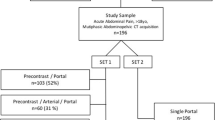Abstract
This study was performed to evaluate whether consecutive arterial phase and portal venous phase scans of the upper abdomen are contributory in the evaluation of the liver in patients with blunt abdominal trauma. The purpose of the study was to determine whether such dual acquisition using helical computed tomography (HCT) provides improved definition of injuries and significant information about the dynamics of posttraumatic hemorrhage.
During a 10-month period, all patients referred for evaluation of blunt abdominal trauma were scanned using a dual phase imaging technique. Two consecutive and comparable scan clusters were programmed to study the upper abdomen, with a slice collimation of 10 mm and a 1∶1 pitch. Intravenous contrast medium was delivered at a rate of 2 ml/sec for a total of 125 ml, with scan delays of 30 and 70 seconds (arterial and venous phases of hepatic enhancement).
Thirty-two patients with hepatic lacerations were encountered, and the images from both acquisitions were compared and graded according to lesion conspicuity. The presence of contrast medium extravasation associated with parenchymal injuries was also recorded.
In 23 (72%) of the 32 patients, the liver injuries were better defined in the portal venous phase, and in eight (25%) patients, the lesions were equally shown in both phases. In only one case, the lesion was better demonstrated in the arterial phase. Contrast medium extravasation was noted in two patients at the site of liver laceration. In three additional cases, contrast medium extravasation was also noted in associated splenic injuries. In all of these patients, the extravasation (bleeding laceration) was seen only in the images corresponding to the portal venous phase.
Dual phase HCT of the upper abdomen does not provide significant additional information in the evaluation of patients with liver injuries resulting from blunt abdominal trauma. With a single scan cluster through the upper abdomen after a 70-second injection-scan delay, lesion definition is optimal, and vascular opacification remains adequate.
Similar content being viewed by others
References
Moon KL, Federle MP. Computed tomography in hepatic trauma. AJR Am J Roentgenol 1983; 141:309–14.
Federle MP, Jeffrey RB. Hemoperitoneum studied by computed tomography. Radiology 1983; 148:187–92.
Mirvis SE, Whitley NO, Vainwright JR, Gens DR. Blunt hepatic trauma in adults: CT-based classification and correlation with prognosis and treatment. Radiology 1989; 171:27–32.
Shanmuganathan K, Mirvis SE, Sover ER. Value of contrast-enhanced CT in detecting active hemorrhage in patients with blunt abdominal or pelvic trauma. AJR Am J Roentgenol 1993; 161:65–9.
Foley WD, Cates JD, Fellman GM, et al. Treatment of blunt hepatic injuries: role of CT. Radiology 1987; 164:635–8.
Umlas SL, Cronan JJ. Splenic trauma: can CT grading systems enable prediction of successful nonsurgical treatment? Radiology 1991; 178:481–7.
Jeffrey RB Jr. CT diagnosis of blunt hepatic and splenic injuries: a look to the future. Radiology 1989; 171:17–8.
Heiken JP, Brink JA, Vannier MW. Spiral (helical) CT. Radiology 1993; 189:647–56.
Foley WD, Hoffmann RG, Quiroz FA, et al. Hepatic helical CT: contrast material injection protocol. Radiology 1994; 192:367–71.
Herts BR, Paushter DM, Einstein DM, et al. Use of contrast material for spiral CT of the abdomen: comparison of hepatic enhancement and vascular attenuation for three different contrast media at two different delay times. AJR Am J Roentgenol 1995; 164:327–31.
Hollett MD, Jeffrey RB Jr, Nino-Murcia M, et al. Dual-phase helical CT of the liver: value of arterial phase scans in the detection of small (≤1.5 cm) malignant hepatic neoplasms. AJR Am J Roentgenol 1995; 164:879–84.
Silverman PM, Cooper C, Trock B, et al. The optimal temporal window for CT of the liver using a time-density analysis: implications for helical (spiral) CT. J Comput Assist Tomogr 1995; 19: 73–9.
Author information
Authors and Affiliations
Rights and permissions
About this article
Cite this article
Nuñez, D., Wester, J.D., Lentz, K.A. et al. Helical computed tomography of liver injuries: A trial of dual phase imaging. Emergency Radiology 3, 20–24 (1996). https://doi.org/10.1007/BF01508161
Issue Date:
DOI: https://doi.org/10.1007/BF01508161




